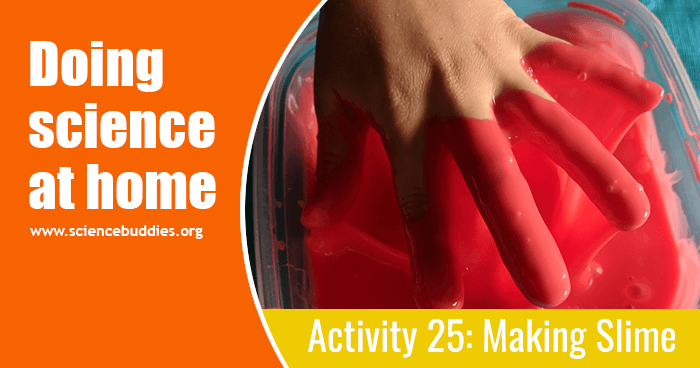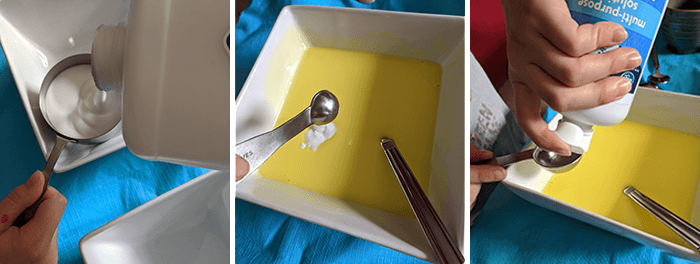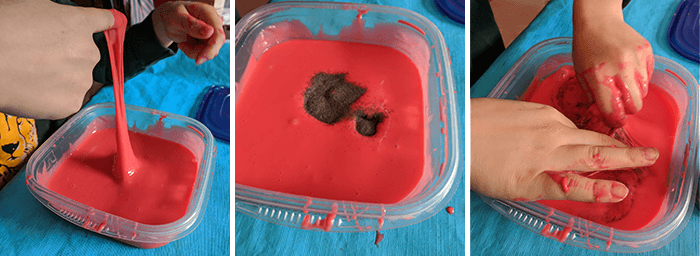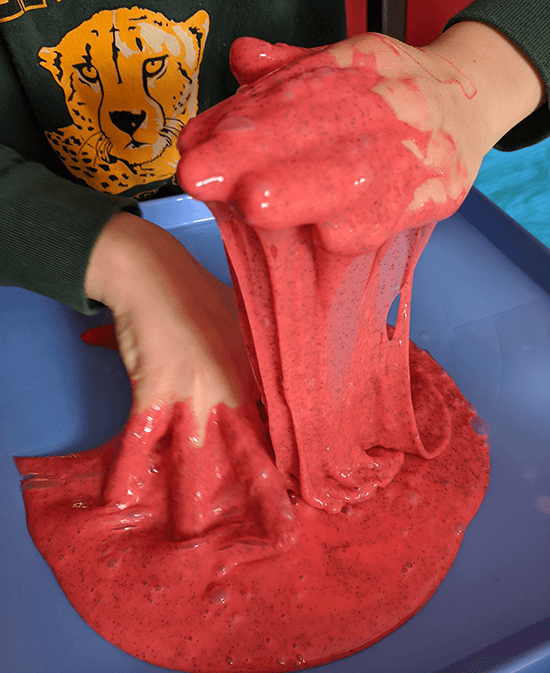Slime Three Ways: Doing Fun Science at Home during School Closures (Activity #25)
Follow along with a Science Buddies parent who is using family STEM activities to keep her kids learning at home during the COVID-19 school shutdown. New posts every Monday, Wednesday, and Friday. Today's adventure... making several different types of oozy slime.

Slimy, Goopy, Tactile Fun
The messier the better — that's what my kids seem to think. From mud pies to crazy food concoctions, my children have always loved mixing up ingredients to make unique mixtures. While some kids are overwhelmed by mixtures with unusual tactile qualities, other kids embrace them. My kids definitely fall in the "embrace them" category. They seem to have a particular love for slimy, gloopy, sticky, weird-feeling mixtures. They aren't alone. There is a reason the toy industry creates things like playdough, silly putty, gak, and what feels like a million different versions of slime.
There is a lot of science behind these types of mixtures, and much of that science can easily be explored at home. Here are a few simple-to-make and crazy-fun-to-explore tactile mixtures:
- Turn Milk into Plastic: no, it's not a joke. You really can turn warm milk into a moldable plastic with a simple vinegar reaction.
- How to Make Slime: glue, baking soda, and contact solution are the basis for this goopy fun material. Once you get the basic recipe down, there are lots of variations to make.
- Oobleck: A Recipe for a Mesmerizing Mixture: this fantastical material acts like a solid when you apply pressure, but it flows like a liquid when left alone.
- Make Your Own Marshmallows: if you're looking for a tasty tactile experience, experiment with how this gloopy material sets up into delicious treats.
- Gelatin Pearls: gelatin has a bizarre texture in its own right, and trying to shape it into balls lends a whole new dimension of fun to explore.
My Pick of the Day: Slime, Slime, and More Slime
If your kids are in the 4th grade or above, you may recall that slime was hugely popular a few years ago. While it is not quite as popular now, it's not any less fun, which is why I chose to do the How to Make Slime activity with my kids. This activity had been on my doing science at home adventure list because it is fast to do, but it has tons of playing and exploring time. Basically, your kids are designing and making their own toy, which makes it similar in my house to the kite, toy car, and catapult activities, all of which my kids have loved.
Slime also came up this weekend when we were watching STEM videos. In particular, my kids loved the idea of the magnetic slime, which you can see in action at the 2:10 mark in the video:
We decided to dive in and make three different types of slime: regular slime; the fabled magnetic slime, which has iron filings mixed in; and fluffy slime, which incorporates shaving cream to give it an airier texture. As I said, slime had been on my list, so a few weeks ago I ordered a large bottle of glue and made sure we had contact lens solution and iron filings on hand. We had extra shaving cream left over from our paper marbling activity, so we were all set with materials.
Note: There are tons of recipes for making slime all over the internet; most of them call for glue and some kind of boric acid. The chemical reaction between these two ingredients causes long polymers to form from the glue and gives slime its stretchy texture. The ratio of the ingredients controls the consistency of the slime. Science Buddies' recipe calls for contact solution that has boric acid in the ingredients. We choose to use this, rather than Borax, a cleaning reagent, because very few kids have any reaction to the contact solution recipe. (Some kids have a reaction to Borax.) However, kids with very sensitive skin, or kids who play with slime daily for many days, may still have reactions even with the contact solution formula. If you are concerned, you can always have your kids wear gloves. You can see from the photos that we did not wear gloves as skin irritations are uncommon if you are just playing with the slime for a few days.
The kids got out three bowls, and we dumped half a cup of glue in each bowl plus our food colorings of choice. My second-grader thought we should go for flame colors, so we chose red, orange, and yellow for our three types of slime. For both the regular slime and the magnetic slime, we followed the basic recipe of adding water (a half cup), baking soda (half a teaspoon), and contact solution with boric acid (two tablespoons) to the glue.

What came next was a lot of mixing and kneading until the polymers had formed and the slime had thickened. If this is your first time making slime, you may think it isn't working, but trust the recipe! Give it ten minutes of kneading, and you'll see slime take shape.
We left the regular slime (yellow) alone and added approximately a tablespoon of iron filings to the red slime to transform it into magnetic slime. Both of these slimes felt great. They reacted just as you expect slime to — they oozed out of your hand while also acting bouncy when poked.

To make our fluffy slime (orange), we substituted the water for three cups of shaving cream. The result was bizarre. It held together much more than shaving cream does on its own, and even after 24 hours, the shaving cream slime remained fluffy. But it never firmed up as much as the other slimes. It was slightly slippery and didn't ooze or stretch the way the regular and magnetic slimes did.
Once our three slimes were made, the kids spent over an hour playing with them and exploring them. They particularly enjoyed the magnetic slime and watching it interact with a small neodymium magnet we had. It only took a minute of experimenting to have the magnet covered in small iron filings it had attracted from the slime. In contrast, the fluffy slime was our least favorite. We all agreed that we would want to try tinkering with that recipe if we did the activity again. It was just too sticky compared to the other slimes.

Overall, the slime was so popular that my second grader pulled all three batches out again the next day to keep playing with them. She especially enjoyed seeing what happened when she mixed them all together. (That, of course, was the end of the three separate slimes.)
Everyone in my house agreed that this is an activity that you can have fun repeating over and over, especially if you tweak the recipe in different ways to get different effects. Because this activity is one your kids might want to do again, you might want to plan ahead with that in mind and get a mega bottle of washable school glue!
If your kids make one or more slime variations or try any of the other tactile mixtures , we'd love to see. Post a picture of what they make on social media and tag us. You can find us on Twitter, Facebook, and Instagram.
If this blog post was useful to you, please share it with other parents. Follow the links below to see what other science adventures we've been having at home.
View All Posts in this Series
- Activity 1 - Getting Started and Hand Washing
- Activity 2 - Taking Flight with Kites
- Activity 3 - Candle Seesaw and Fire Science
- Activity 4 - Dissecting Flowers
- Activity 5 - Building a Toy Parachute
- Activity 6 - Paper Marbling
- Activity 7 - Shaping Hard-boiled Eggs
- Activity 8 - Invisible Ink
- Activity 9 - Robot Hand
- Activity 10 - Plastic Egg Rockets
- Activity 11 - Rubber Band Guitar
- Activity 12 - Making Model Viruses
- Activity 13 - Air Cannons
- Activity 14 - Balancing an Art Mobile
- Activity 15 - Gumdrop Geometry
- Activity 16 - Solar Updraft Tower
- Activity 17 - Cotton Ball Launcher
- Activity 18 - Wire Water Striders
- Activity 19 - Ice Cream in a Bag
- Activity 20 - Wind-powered Sail Cars
- Activity 21 - Curling Metal
- Activity 22 - Popsicle Stick Catapult
- Activity 23 - Candy Diffusion
- Activity 24 - STEM Videos
- Activity 25 - Making Slime
- Activity 26 - Straw Siphon
- Activity 27 - Elephant Toothpaste
- Activity 28 - Balloon Hovercraft
- Activity 29 - Aluminum Foil Boats
- Activity 30 - Wall Marble Run
A science activity log is available as a Word document or as a Google doc for online convenience. (Just choose "File/Make a copy" to save it to your Google Drive.)
About the Author
Sandra, Science Buddies' Vice President of STEM education, holds a PhD in Genetics from Stanford University and has spent the last twelve years working on science education and STEM outreach. Right now, she's stuck working from her home in the Pacific Northwest with her husband, second grader, middle schooler, and two oddly noisy gerbils. She hypothesizes her sanity will hold as long as she gets a daily dose of sunshine.
Categories:
You Might Also Enjoy These Related Posts:
- Wall Marble Run: Doing Fun Science at Home during School Closures (Activity #30)
- Aluminum Foil Boats: Doing Fun Science at Home during School Closures (Activity #29)
- Hovercraft: Doing Fun Science at Home during School Closures (Activity #28)
- Elephant Toothpaste: Doing Fun Science at Home during School Closures (Activity #27)
- Straw Siphon: Doing Fun Science at Home during School Closures (Activity #26)
- Slime Three Ways: Doing Fun Science at Home during School Closures (Activity #25)
- A STEM Videos Breather: Doing Fun Science at Home during School Closures (Activity #24)
- Candy Experiments: Doing Fun Science at Home during School Closures (Activity #23)










